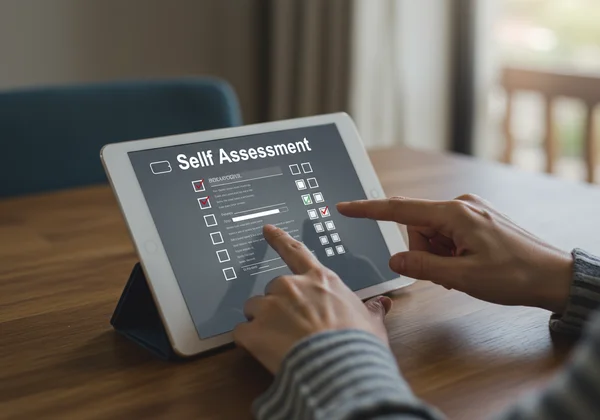Managing AVPD Traits: 10 Practical Coping Strategies & Taking the AVPD Test
Feeling overwhelmed by a constant fear of rejection, intense self-consciousness, and a powerful urge to avoid social situations? You're not alone. This internal struggle is at the heart of Avoidant Personality Disorder (AVPD) traits. While understanding these feelings is the first step, the next is discovering actionable ways to manage their impact on your life. This guide offers ten practical AVPD coping strategies designed to empower you.
The journey toward connection and comfort begins with self-awareness. But how do you know if you have avoidant personality disorder? Gaining clarity on your personal patterns is crucial. A great place to start is with a confidential self-assessment that can provide initial insights. Exploring your traits with a free online AVPD test can illuminate the path forward, helping you choose which of these strategies to focus on first.

Foundational AVPD Coping Strategies
Before tackling complex social situations, building a strong internal foundation is essential. These strategies focus on changing your relationship with yourself, creating a safer inner world from which you can begin to explore the outer one.
Cultivating Self-Compassion & Acceptance
For many with avoidant personality traits, the inner critic is loud and relentless. Self-compassion is the practice of turning down that volume and replacing it with a voice of kindness. It means treating yourself with the same care you would offer a friend who is struggling. Instead of berating yourself for feeling anxious, acknowledge the feeling without judgment. Acceptance isn't about giving up; it's about ending the exhausting internal war and saving your energy for gentle, positive change.

Gradual Exposure: Gentle Steps Out of Your Comfort Zone
The thought of diving into a feared social situation is terrifying. Gradual exposure breaks this down into tiny, manageable steps. The goal is not to eliminate fear but to learn that you can survive it. Start with something that feels only mildly uncomfortable, like making eye contact with a cashier or spending ten minutes in a coffee shop alone. Celebrate these small victories. They build the evidence your brain needs to believe that you are more capable than you think.
Embracing Mindfulness and Grounding Techniques
Anxiety can feel like a tidal wave, pulling you into a future filled with catastrophic "what-ifs." Mindfulness and grounding techniques are anchors that keep you in the present moment. A simple grounding exercise is the 5-4-3-2-1 method: pause and name five things you can see, four things you can touch, three things you can hear, two things you can smell, and one thing you can taste. This pulls your focus away from anxious thoughts and back to your immediate, safe reality.
Practical Self-Help for Managing AVPD Daily
With a stronger foundation, you can begin to implement practical strategies to navigate daily life more effectively. These tools are designed for in-the-moment challenges and long-term pattern shifts.
Challenging Negative Core Beliefs
AVPD is often fueled by deep-seated negative beliefs like "I am defective" or "If people knew the real me, they would reject me." Cognitive restructuring involves learning to identify, question, and challenge these thoughts. When you catch yourself thinking something harsh, ask for evidence. Is it 100% true that everyone dislikes you? Is there an alternative, more balanced way to see the situation? This practice helps weaken the power of these automatic negative thoughts over time.

Developing Emotional Regulation Skills
Intense sensitivity to rejection means emotions can feel overwhelming. Emotional regulation is the skill of noticing and managing your feelings without letting them take over. Start by simply naming your emotions: "I am feeling anxious," or "I am feeling hurt." Journaling is a powerful tool for this, allowing you to pour your feelings onto a page in a private, safe space. Understanding what you feel is the first step toward deciding how you want to respond.
Setting Realistic Social Goals and Boundaries
If you haven't been socially active, setting a goal to attend a huge party is a recipe for overwhelm. Instead, set small, realistic social goals. This could be as simple as sending one text message to a friend this week. Equally important is setting boundaries. It's okay to leave an event early or decline an invitation if you feel drained. Boundaries are not about pushing people away; they are about protecting your well-being so you have the energy for the connections that matter most. If you're unsure where to begin, an AVPD self-assessment can help identify your specific social challenges.
Building Resilience: How to Cope with AVPD Long-Term
Lasting change is a marathon, not a sprint. These long-term strategies focus on building resilience, fostering genuine connection, and creating a life that feels authentic and supportive.
Improving Communication Skills for Connection
When you fear criticism, it can be difficult to express your needs or feelings. Practicing assertive communication can transform your interactions. Use "I" statements to own your feelings without placing blame (e.g., "I feel a bit overwhelmed when plans change suddenly" instead of "You're stressing me out"). Practicing these conversations with a trusted friend or in a journal can build confidence for real-world situations.
Seeking Safe & Supportive Connections
While the instinct may be to withdraw, connection is a fundamental human need. The key is to seek it in safe environments. Focus on quality over quantity. This could mean deepening a relationship with one or two trusted family members or friends. It might also involve joining a small hobby group—like a book club or hiking group—where the focus is on a shared activity, taking the pressure off direct social interaction.

Establishing Healthy Routines and Self-Care Habits
Your mental and physical health are deeply connected. Consistent routines provide a sense of stability and predictability that can be very calming for an anxious mind. Prioritize good sleep hygiene, balanced nutrition, and gentle movement. View self-care not as an indulgence, but as a vital part of your mental health toolkit. It's about creating a lifestyle that actively supports your journey.
Understanding When to Seek Professional Support
These self-help strategies are powerful tools for managing avoidant personality traits. However, working with a mental health professional can provide personalized guidance, support, and therapeutic techniques like Cognitive Behavioral Therapy (CBT) or psychodynamic therapy. A therapist can create a safe space to explore the roots of your fears and develop a tailored roadmap for healing.
Disclaimer: This article is for informational purposes only and is not a substitute for professional medical advice, diagnosis, or treatment. The online screening tool on this site is an educational resource to help identify traits and is not a diagnostic tool. Please consult with a qualified healthcare provider for any health concerns.
Empowering Your Journey: Taking Steps Forward
Managing the traits of AVPD is a journey of small, courageous steps. It's about treating yourself with compassion, challenging old patterns, and slowly building a life that feels more open and connected. Each strategy here is a tool you can use to empower yourself, one day at a time.

Remember, understanding is the first step to empowerment. If you relate to the struggles described here and want to gain more clarity, take our free AVPD test today. It's confidential, instant, and could be the first step on your path to greater self-awareness and well-being.
Frequently Asked Questions About AVPD Coping
How can I help myself if I have avoidant personality disorder?
You can start by practicing self-compassion, challenging negative thoughts, and gently exposing yourself to feared situations in small steps. Developing emotional regulation skills and setting healthy boundaries are also key. Many find that using an online AVPD screening tool is a helpful first step to organize their thoughts before exploring these strategies or seeking professional help.
What are the main symptoms of AVPD?
The core symptoms of AVPD, based on DSM-5 criteria, include feelings of inadequacy, extreme sensitivity to criticism or rejection, avoidance of social or occupational activities that involve significant interpersonal contact, and restraint within intimate relationships for fear of being shamed or ridiculed. It's a pervasive pattern of social inhibition.
Is avoidant personality disorder the same as being shy?
While they can look similar, they are different. Shyness is a common personality trait where someone feels awkward in new social situations but usually warms up over time. AVPD is a more severe and pervasive condition where the avoidance and fear of rejection are so intense that they significantly disrupt a person's life, career, and ability to form close relationships.
What does high functioning AVPD look like?
Someone with high-functioning AVPD may be able to maintain a job and have a few relationships, but they do so with immense internal distress. They might appear successful on the outside but internally struggle with intense self-doubt and fear of their colleagues or friends discovering their perceived flaws. They often expend a huge amount of energy to "perform" normally in social settings, leading to exhaustion and burnout.